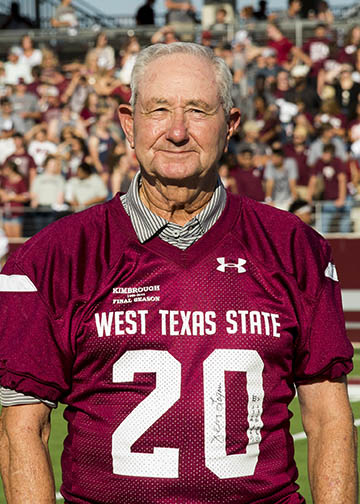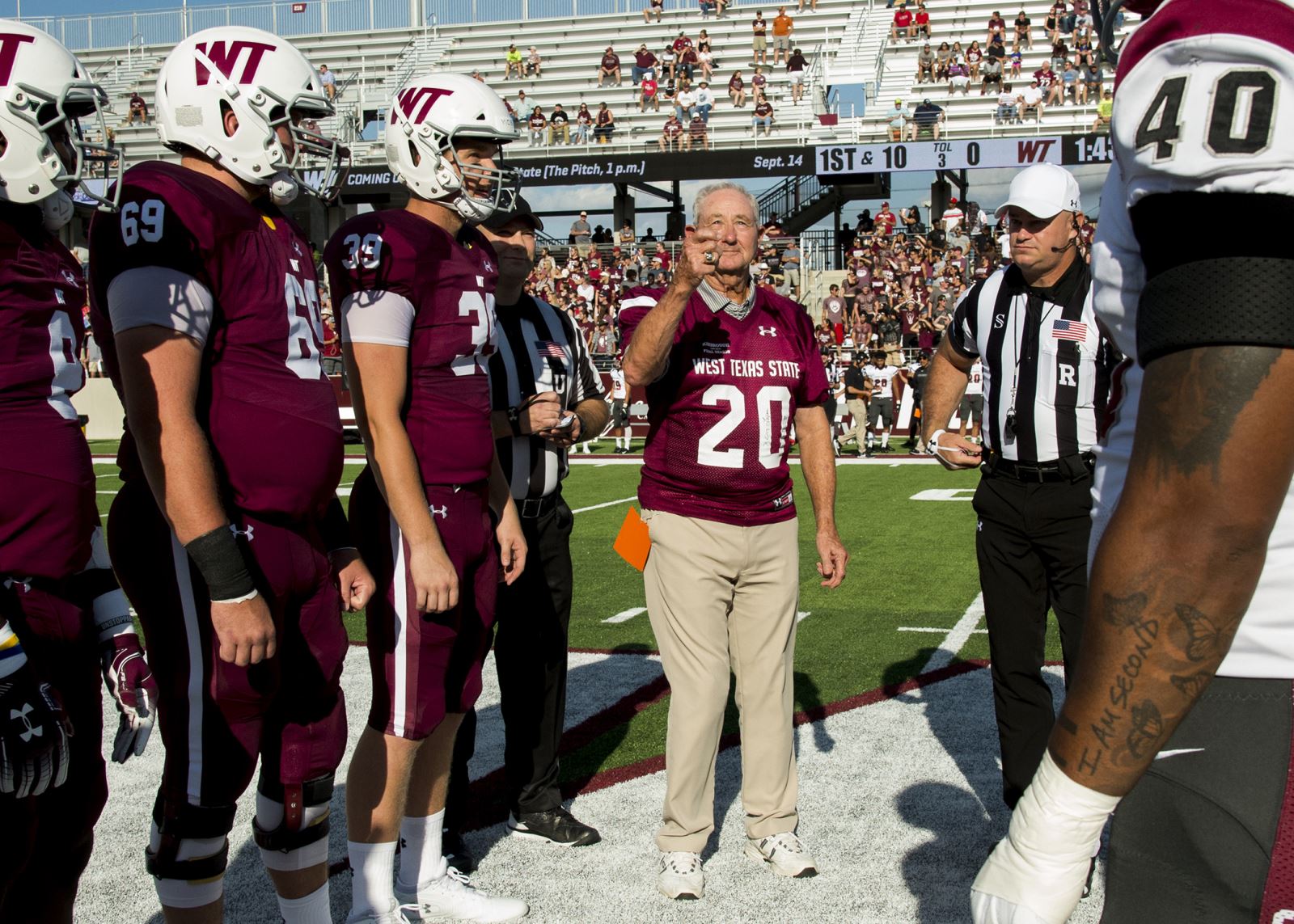- Athletics
- Jon Mark Beilue
- Community
- Alumni
An All-Time Great Comes Home
Logan helped open Buffalo Stadium — 'a tremendous honor'
Despite being a standout two-way football player for the Graham Steers in the late 1950s, Jerry Logan was looked upon by most colleges as a 6-foot, 150-pounder who just didn’t project at the next level.
Oh, a couple of nearby junior colleges took an interest in him, and Logan was set to go that route but a neighbor stepped in. He knew West Texas State coach Frank Kimbrough. When Kimbrough was in the area on a recruiting trip, he was urged to at least look at Logan.
Kimbrough went by the high school and looked at some grainy film of Logan in action. Then he went to talk with him and made him a conditional offer.
"He said, 'I’ll tell you what I’ll do, if you come to West Texas and go through preseason practice, and if you’re good enough to make the team, I’ll offer you a scholarship,’" Logan said.
"My parents drove me to Canyon, and I’d never been more than 200 miles from Graham in my life. They dropped me off in front of Connor Hall and told me good luck, and I thought, 'OK, here I am. Now what do I do?’"
Sixty years later, Jerry Logan returned to Canyon from Graham, this time to help christen the new Buffalo Stadium. Sixty years ago, he was a wiry walk-on. This time, he returned as not only a great-grandfather, but perhaps the greatest football player in WT history.
He would have a 10-year NFL career as a safety with the Baltimore Colts, where he was named All-Pro three times. With the Buffs, he was a two-way player, who never left the field and led the country in scoring in the Sun Bowl season of 1962.
It was a homecoming of sorts for Logan, four weeks before this week’s official WT homecoming. He returned with 13 family members to the new on-campus stadium that seats 8,500. 
"It’s a tremendous honor," he said.
Never left the field
In 1959, he was one of five freshmen to play on the Buffalo varsity team that opened a new stadium as well, the 20,000-seat Buffalo Bowl, renamed Kimbrough Stadium in the 1970s.
"It was kind of intriguing the way the design was," Logan said, "underground like it was. I liked it the first time I saw it, but truthfully, I was just trying to make the football team. I didn’t care where we played."
In Logan’s sophomore season of 1960, there was a new sheriff in town. Joe Kerbel arrived as head coach. There was a new way of doing things - his way. Gruff, demanding, his large presence cast an imposing shadow over all WT teams throughout the 1960s, a decade that included two bowl victories.
"You might get a different story from someone else, but Coach Kerbel was always fair to me," Logan said. "There were no fence riders. If you were a football player, you fell on one side. If you weren’t and you just went through the motions, you fell on the other, and you weren’t going to be around very long.
"He gave some players absolute heck. One of the guys one time said, 'I don’t understand. He doesn’t ever say anything bad to you.’ I said, 'Well, he won’t if you aren’t doing anything wrong.’ It was kind of an inside joke."
Logan grew to 190 pounds and became a Swiss Army knife for the Buffs. It was the last years of college players attempting two-platoon football, and Logan literally never came off the field.
He was a running back on offense, a cornerback on defense. He was the placekicker. He returned punts and kickoffs, and played safety on the kickoff team. Logan would occasionally take a play off when the Buffs punted.
"I didn’t know any different until I got to the pros," Logan said. "That’s the way it was in high school, and that’s the way it was in college. I got to the NFL, and I thought, 'Gosh, this is like playing half the game. This is a piece of cake.’"
In Logan’s senior season in 1962, the Buffs were 9-2, including a 15-14 win over Ohio University in the Sun Bowl, an era in which there were just eight bowls. Included in that season was a 30-27 win over Texas Tech and a 15-14 win over Arizona State.
Logan led the country that year in scoring with 13 touchdowns and a slew of extra points and a field goal tucked in here and there.
"It was a nice honor," he said, "and Coach Kerbel wanted me to get that bad."
Ten years with the Baltimore Colts
After the Sun Bowl, Logan flew to Mobile, Ala., for the Senior Bowl. Kerbel had plenty of NFL contacts among scouts, and he’d been touting Logan for two years. At the Senior Bowl, Logan saw in practice that week and in the game that he could play right with the best in the country.
"Without Joe Kerbel, I wouldn’t have had the skills or been prepared to go to the pros as I was," he said. "And like we said, if you could survive Joe Kerbel, you could survive anywhere."
Logan and other white teammates learned of Kerbel’s color-blindness. He recruited black athletes Pete Pedro and Ollie Ross years before major colleges in Texas did. They saw each other for what they were - teammates and friends.
"You could tell they were a little scared in this environment, but Corky Dawson and I grabbed them by the arms and told them we were here to play football, that you stay with us and you’ll be fine," Logan said.
Logan was drafted in the fourth round of the 1963 draft by Baltimore, the 47th player taken. He played 10 seasons for the Colts, retiring in 1972. Three times, he was named All-Pro and had 34 interceptions in his career.
He played two Super Bowls - III when the New York Jets notched a huge upset, and in V when Baltimore edged the Cowboys. In that game, Logan caused a fumble and had an interception. He played seven years for Don Shula, the NFL’s winningest coach.
"He was a lot like Kerbel," Logan said, "but not in an abusive way. He was a real tactician - fundamentals, fundamentals, fundamentals. But I was used to all that."
Logan, 78, has remained in Graham since NFL retirement. He and his wife Fannie, a native of Dumas who Logan met at WT, wanted to raise their four children in a small town. Plus, it gave him an opportunity to get back to the family ranch that’s between Graham and Jacksboro.
In early September, it was a rare trip back to campus. But one that he was honored for being asked, and one that left him impressed with the changes.
Logan said he was raised to appreciate hard work and dedication, and to have confidence in himself. He tried to sell that to the current Buffs he spoke to the first weekend in September as honorary team captain.
"I told them that you have a God-given talent, but you have to dedicate yourself to be the best you can be," Logan said. "You have to be committed and work your rear end off every day. The other is be the best teammate you can be, play for the school, play for your school."
Do you know of a student, faculty member, project, an alumnus or any other story idea for "WT: The Heart and Soul of the Texas Panhandle?" If so, email Jon Mark Beilue at jbeilue@wtamu.edu.
—WTAMU—

